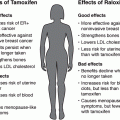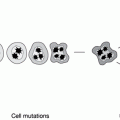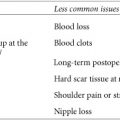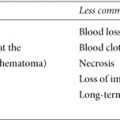Chapter 16
Young and at High Risk
ANYONE DEALING WITH HEREDITARY CANCER ISSUES has special concerns and challenges, no matter what her age. If you’re a young woman, you face additional uncertainties surrounding the risk and reality of cancer at a time in your life when you have fewer resources and probably have little experience with serious disease. You may be working hard to position yourself professionally or start a family or you may already have young children. Although most women diagnosed with breast or ovarian cancer are 50 or older, your genetic predisposition translates to high risk before that age and increased risk even during your twenties and thirties.
Should You Consider Testing Now?
Young Previvors
If cancer runs in your family, will you benefit from being tested now? If you test positive, you’ll face complex decisions. How do you balance the concern of developing cancer with a lifetime of high-risk surveillance, chemoprevention with life-changing side effects, or body-altering surgery? You may struggle to determine whether you should have prophylactic mastectomies to reduce your risk, and question the best time to do so. Your healthcare team can help you sort through these issues, even if you’re not ready to be tested now.
MY STORY: A New Understanding
If I had a crystal ball, I’m not sure I’d want to know now what the future might reveal. When I’m 18, I’ll decide whether or not to be tested. No matter what my result, I’ll always be a part of a family with hereditary cancer. My mom, grandmother, aunt, great-aunt, and two cousins have a BRCA mutation and have had breast cancer. Cancer is the furthest thing from the minds of most people my age, but not for me. My family’s genetic background has given me a new understanding that sets me apart from my peers. Even though it was frightening to watch my mother go through treatment, her courage comforted me. Now I see that ignoring my fears doesn’t take away my risk, and none of us is invincible. Mom used to say that living with cancer risk was like having a dark cloud over her. My cloud might appear in that crystal ball. I’m pretty sure that someday, I’ll have the strength to take a look.
—ARIELLE
Young Women in Treatment
If you’ve had breast cancer and you’re not yet 40, you’re not alone. Although you may be the youngest person in your oncologist’s office, over 250,000 young women with breast cancer have been there before you.1 If you have breast cancer before age 50 or ovarian cancer at any age, NCCN guidelines recommend you consult with a genetic counselor and consider BRCA testing. While young previvors usually have plenty of time to consider risk management options, if you develop cancer, you need to make more immediate treatment decisions, which may be influenced by knowledge of your mutation status. Some women prefer to delay testing until they complete treatment, rather than trying to grapple with new information and decisions under pressure.
Diagnostic Difficulties
Screening high-risk women for breast cancer before age 40 with clinical breast exam, mammogram, and MRI is very effective, but it’s not foolproof. Mammography is good at finding microcalcifications (changes in breast tissue that could indicate cancer); it’s not as good at finding masses in the dense breast tissue seen in young women. Additionally, some experts propose that the accompanying increased lifetime exposure to radiation from starting annual mammograms before age 30 could lead to a slightly increased breast cancer risk. MRI is more sensitive to breast changes. It often finds suspicious areas that prove to be benign, increasing the chance of unnecessary biopsies.
Despite these concerns, expert guidelines recommend a combination of annual MRI and mammogram beginning at age 25 or ten years younger than the earliest breast cancer diagnosis to maximize the chances of finding breast cancer early in high-risk women. Because younger women who develop breast cancer often discover it themselves when they find a lump or change through breast awareness or self-exam, being aware of your body and learning proper BSE technique is equally important.2 Don’t ignore a lump, discharge, or other suspicious symptom, even if it appears in your twenties or thirties and you believe you’re too young to develop breast cancer. Tell your doctor right away. Sometimes, doctors assume a young woman’s symptoms are due to harmless cysts and decide to wait and see what develops. If you have a BRCA mutation or a family history of cancer, choose doctors with expertise in managing high-risk women, and make them aware of your genetic status. Have any lump or breast change thoroughly examined and preferably biopsied. Appropriate risk management is important. Talk to your healthcare team about the NCCN guidelines as described in chapter 8.
Dealing with a Diagnosis before Menopause
Treatment options are often the same regardless of your age at diagnosis. Before menopause, however, standard procedures, including surgery, radiation, chemotherapy, and hormone therapy can have a greater impact on your sexuality, self-image, and fertility.
Your treatment may cause early menopause or menopausal symptoms. You’re more likely to have hot flashes and other symptoms the closer you are to natural menopause, and especially if you’re in your late thirties or forties. Menopause caused by chemotherapy may be temporary or irreversible, depending on the specific medication used. Some oncologists treat premenopausal women with monthly injections of leuprolide acetate (Lupron) or goserelin (Zoladex), medications that stop your ovaries from producing estrogen. You’ll go into premature menopause as a result. If you’re at high risk for ovarian cancer due to a BRCA mutation or other factors, and have no plans for future pregnancies, oophorectomy is often recommended instead to permanently stop estrogen production and dramatically lower your risk for ovarian cancer.
Research shows that BRCA mutation carriers with ovarian cancer respond better to treatment and survive longer than women who don’t have a mutation.3 Your treatment will involve bilateral salpingo-oophorectomy, which will also lower your risk for breast cancer. That’s important, because after treatment, you’ll still have high risk for cancer in either breast. You’ll need routine screening according to recommended guidelines for high-risk individuals. Some ovarian cancer survivors consider having prophylactic mastectomy to lower their risk. The decision is individual and often depends on the extent of your cancer and your prognosis.
Young Menopause
If your treatment results in menopausal symptoms that just won’t quit, your options for hormonal therapy are limited. Coping with hot flashes, reduced libido, and other menopausal symptoms can make young women feel they’re sacrificing their youth and fertility to treat their cancer. Most oncologists won’t prescribe hormones after breast or ovarian cancer. Some doctors first recommend vaginal estrogen to alleviate vaginal dryness. In situations where no other remedy restores your quality of life, some oncologists may prescribe low-dose hormones if your tumor was hormone receptor–negative, you had bilateral mastectomies, and your treatment is at least three years behind you. If you’re a survivor with menopausal symptoms that disrupt your life, speak with your oncologist about the benefits and risks of each option described in chapter 13.
Planning Your Family, Preserving Your Fertility
Having a BRCA mutation raises unique family planning and fertility issues that may otherwise never have surfaced. Topics you may not have thought much about, such as breastfeeding, timing of pregnancies, or choice of birth control, may take on new significance.
Birth Control
Taking oral contraceptives slightly elevates breast cancer risk in the general population. When you stop using the Pill, the increase in risk diminishes over time, reverting to average after ten years.4 The most comprehensive study of oral contraceptives in women with BRCA mutations found increased breast cancer only among women who began taking the Pill before 1975 or before age 30, or in women who continued on contraceptives for five years or more. BRCA mutation carriers who took contraceptives for three years after age 30 had a substantially lower risk for ovarian cancer.5 There is little long-term research on newer oral contraceptives, many of which may be less likely to raise breast cancer risk because they contain lower doses of hormones. Solid evidence shows that oral contraceptives reduce ovarian cancer risk. Tubal ligation, which is usually reversible, also prevents pregnancy. It may also lower ovarian cancer risk, yet not as much as oral contraceptives.
Fertility
Cancer treatments and preventive actions that interrupt or end fertility can be a tough pill to swallow if you look forward to future pregnancies. American Society of Clinical Oncology guidelines suggest that oncologists discuss fertility preservation and refer all patients of childbearing age to specialists.6 If fertility is a concern, discuss your treatment options with your oncologist and ask for a referral to a fertility specialist before beginning any chemotherapy.
Several studies indicate that infertile women may be more likely to develop breast cancer, although no evidence conclusively shows that fertility medications are the cause. Clomiphene citrate (Clomid), a common fertility drug used to treat women who don’t produce enough eggs to become pregnant, isn’t known to increase breast or ovarian cancer risk. It has been linked to an increased chance of uterine cancer.
In Vitro Fertilization
If you’re facing oophorectomy or chemotherapy and want to preserve the option to have your own biological children, you might want to explore in vitro fertilization. Your eggs can be harvested before treatment or surgery and then fertilized with your partner’s sperm outside the womb (in a laboratory). The resulting embryos can be stored until you’re ready to have your baby. If you still have your uterus, you can carry the embryo to term. As an alternative, if you’ve had a hysterectomy, a surrogate can carry the pregnancy for you.
Preimplantation Genetic Diagnosis
The preimplantation genetic diagnosis (PGD) procedure screens embryos to determine whether they’ve inherited their parents’ disease or disease-causing mutation. PGD begins with in vitro fertilization. When an embryo reaches adequate size, one cell is removed and tested; this option is available to test for a BRCA mutation. Only unaffected embryos are implanted into the mother or surrogate.
Breast Cancer and Pregnancy
Breast cancer is difficult to detect during pregnancy or breastfeeding. Normal lumps and thickening can hide more serious changes, and radiation from mammograms may harm the fetus. With their high risk in mind, some previvors have prophylactic mastectomy before they become pregnant. This is a hard choice that eliminates the possibility of breastfeeding, but it provides peace of mind to focus on pregnancy without worrying about surveillance or a diagnosis.
Stay updated, free articles. Join our Telegram channel

Full access? Get Clinical Tree








